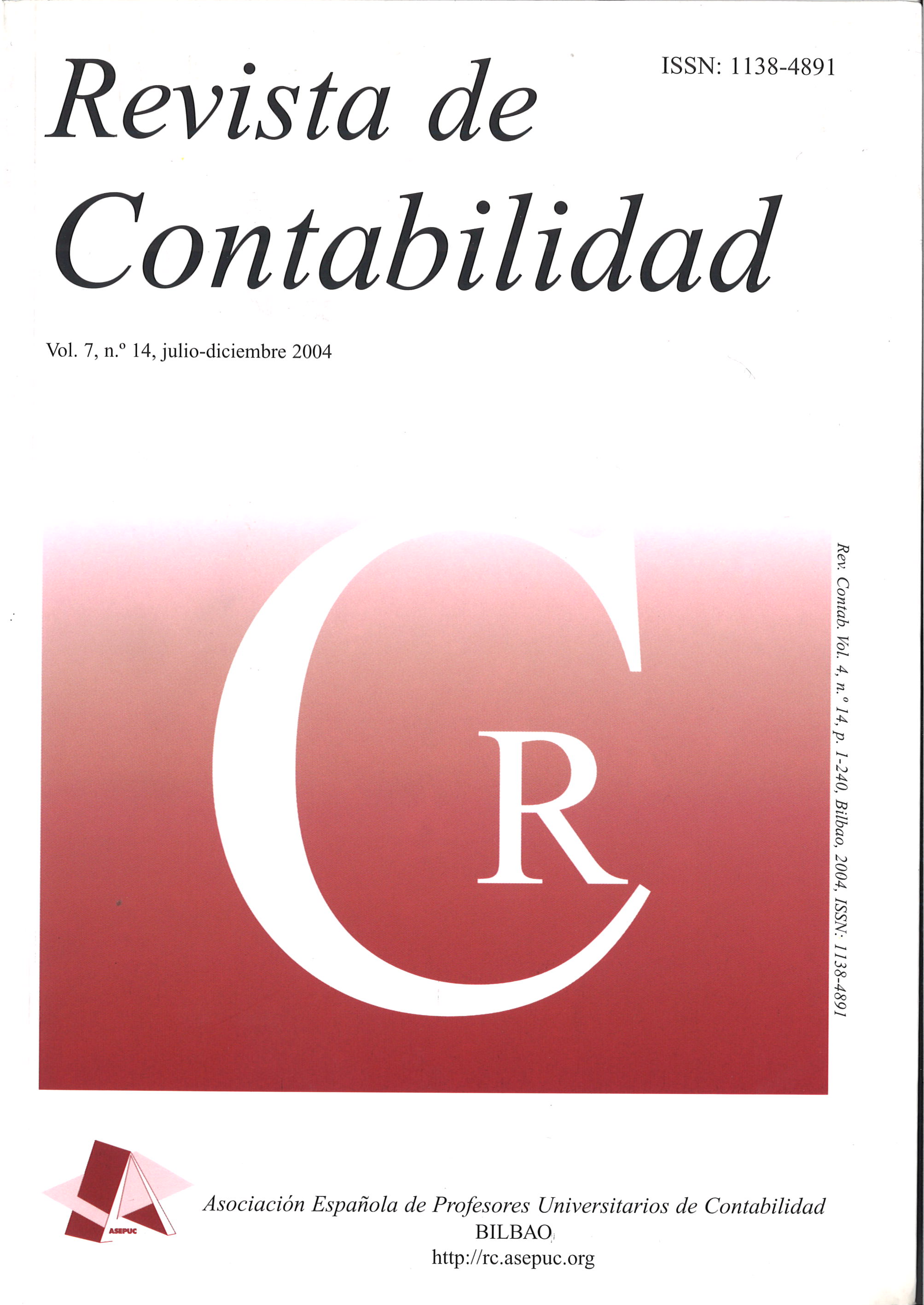Cambios en la Normativa sobre Fondo de Comercio: Algunas Evidencias Empíricas
New Regulatory on Goodwill: Some Empirical Evidences
Resumen
El fondo de comercio constituye una de las partidas más controvertidas entre la doctrina contable. En la actualidad, tras el cambio en la normativa norteamericana, el IASE ha efectuado modificaciones en la misma línea, de forma que, en vez de amortizar este bien, se deberá evaluar anualmente un eventual deterioro del mismo.
En el presente trabajo hemos investigado las consecuencias que para determinados ratios hubiera tenido utilizar un criterio semejante al establecido en la actualidad en las NIIF, utilizando para ello una muestra de 177 sociedades españolas durante el periodo 1998-2000.
Los resultados obtenidos muestran que los ratios de endeudamiento, rentabilidad económica y rentabilidad financiera del periodo analizado se hubieran visto afectados de forma estadísticamente significativa por la eliminación de la amortización sistemática del fondo de comercio. Sin embargo, de cara a la normalización contable, creemos que también se deben tener en cuenta otros factores que se señalan en el estudio.
Descargas
-
Resumen232
-
PDF118
Citas
ASSOCIATION FOR INVESTMENT MANAGEMENT AND RESEARCH (AIMR) (1993): Financial reporting in the 1990s and beyond, Charlottesville, AIMR.
ACCOUNTING PRINCIPLES BOARD (APB) (1970): Intangible assets, Opinion n.º 17, Nueva York, AICPA.
ARCHEL, P.; ROBLEDA, H.; SANTAMARÍA, R. (1995): “Una aproximación empírica al estu- dio de las eliminaciones en las cuentas consolidadas”, Revista Española de Financiación y Contabilidad, vol. XXIV, n.º 24, enero-marzo, p. 59-79.
BARRETT, M.J.; BEAVER, W.H.; COOPER, W.W.; MILBURN, J.A.; SOLOMONS, D.; TWEE- DIE, D.P. (1991): “American Accounting Association Committee on Accounting and Auditing Measurement, 1989-90”, Accounting Horizons, vol. 5, n.º 3, septiembre, p. 81-105.
BARTH, M.E.; BEAVER, W.H.; LANDSMAN, W. R. (2001): “The relevance of the value-relevance literature for financial accounting standard setting: Another view”, Journal of Accounting and Economics, vol. 31, n.º 1-3, p. 77-104.
CEA GARCÍA, J.L. (2002): “En el umbral de la reforma de la regulación contable española ante la adaptación del modelo IASB. Algunas reflexiones desde la disidencia parcial pero sustancial con el libro blanco de la reforma”, Estudios Financieros n.º 236, pp. 153-198.
COLLEY, J.R.; VOLKAN, A.G. (1988): “Accounting for goodwill”, Accounting Horizons, vol. 2, n.º 1, marzo, p. 35-41.
FINANCIAL ACCOUNTING STANDARDS BOARD (FASB) (1999): Exposure Draft: Business Combinations and Intangible assets, Norwalk, FASB.
FINANCIAL ACCOUNTING STANDARDS BOARD (FASB) (2001a): Statement of Financial Accounting Standards n.º 141, “Business Combinations”, Norwalk, FASB.
FINANCIAL ACCOUNTING STANDARDS BOARD (FASB) (2001b): Statement of Financial Accounting Standards n.º 142, “Goodwill and other intangibles assets”, Norwalk, FASB.
GINER, B.; PARDO, F. (2002): “Is goodwill amortization value relevant for share prices? A European perspective”, 25th Annual Congress of the European Accounting Association, Copenhagen.
GORE, P.; TAIB, F.M.; TAYLOR, P.A. (2000): “Accounting for goodwill: An examination of factors influencing management preferences”, Accounting and Business Research, vol. 30, n.º 3, verano, p. 213-225.
HEALY, P.M.; WAHLEN, J.M. (1999): “A review of the earnings management literature and its implications for standard setting”, Accounting Horizons, vol. 13, n.º 4, diciembre, p. 365-383.
HIRST, D.E.; HOPKINS, P.E. (1998): “Comprehensive income reporting and analysts’ valuation judgments”, Journal of Accounting Research, vol. 36, n.º 3, p. 47-75.
HOLTHAUSEN, R.W.; WATTS, R.L. (2001): “The relevance of the value-relevance literature for financial accounting standard setting”, Journal of Accounting and Economics, vol. 31, n.º 1-3, p. 3-75.
HOPKINS, P.E. (1996): “The effect of financial statement classification of hybrid financial instruments on financial analysts’ stock price judgments”, Journal of Accounting Research, vol. 34, n.º 3, p. 33-50.
HOPKINS, P.E.; HOUSTON, R.W.; PETERS, M.F. (2000): “Purchase, pooling, and equity analysts’ valuation judgments”, The Accounting Review, vol. 75, n.º 3, julio, p. 257-281.
INSTITUTO DE CONTABILIDAD Y AUDITORÍA DE CUENTAS (ICAC) (2002): Informe sobre la situación actual de la Contabilidad en España y líneas básicas para abordar su reforma (Libro Blanco para la reforma de la Contabilidad en España), ICAC, Madrid.
INTERNATIONAL ACCOUNTING STANDARD BOARD (IASB) (2004): Activos intangibles, Norma Internacional de Contabilidad n.º 38, Londres, IASB.
JENNINGS, R.; ROBINSON, J.; THOMPSON, R.B.; DUVALL, L. (1996): “The relation between accounting goodwill numbers and equity values”, Journal of Business Finance and Accounting, vol. 23, n.º 4, junio, p. 513-533.
JENNINGS, R.; LECLERE, M.; THOMPSON, R.B. (2001): “Goodwill amortization and the usefulness of earnings”, Financial Analyst Journal, vol. 57, n.º 5, septiembre-octubre, p. 20-28.
JOHNSON, L.T.; PETRONE, K.R. (1998): “Is goodwill an asset?”, Accounting Horizons, vol. 12, n.º 3, septiembre, p. 293-303.
LARRÁN, J.; MONTERREY, J.; MULERO, E. (2000): “Una evaluación empírica del fondo de comercio”, Revista de Contabilidad, vol. 3, n.º 5, enero-junio, p. 101-126.
MOEHRLE, S.R.; REYNOLDS-MOEHRLE, J.A; WALLACE, J.S. (2001): “How informative are earnings numbers that exclude goodwill amortization?”, Accounting Horizons, vol. 15, n.º 3, septiembre, p. 243-255.
PAYNE, J.W.; BETTMAN, J.R.; JOHNSON, E.J. (1993): The adaptive decision maker, Cambridge University Press, Cambridge.
XIE, H. (2001): “The mispricing of abnormal accruals”, The Accounting Review, vol. 76, n.º 3, julio, p. 357-373.
Las obras que se publican en esta revista están sujetas a los siguientes términos:
1. Ediciones de la Universidad de Murcia (EDITUM) y ASEPUC conservan los derechos patrimoniales (copyright) de las obras publicadas, y favorece y permite la reutilización de las mismas bajo la licencia de uso indicada en el punto 2.
2. Las obras se publican en la edición electrónica de la revista bajo una licencia de Creative Commons Reconocimiento-NoComercial-SinObraDerivada 4.0 Internacional. Permite copiar, distribuir e incluir el artículo en un trabajo colectivo (por ejemplo, una antología), siempre y cuando no exista una finalidad comercial, no se altere ni modifique el artículo y se cite apropiadamente el trabajo original. Esta revista no tiene tarifa por la publicación Open Access. ASEPUC y EDITUM financian los costes de producción y publicación de los manuscritos.
3. Condiciones de auto-archivo. Se permite y se anima a los autores a difundir electrónicamente la versión publicada de sus obras, ya que favorece su circulación y difusión y con ello un posible aumento en su citación y alcance entre la comunidad académica.







